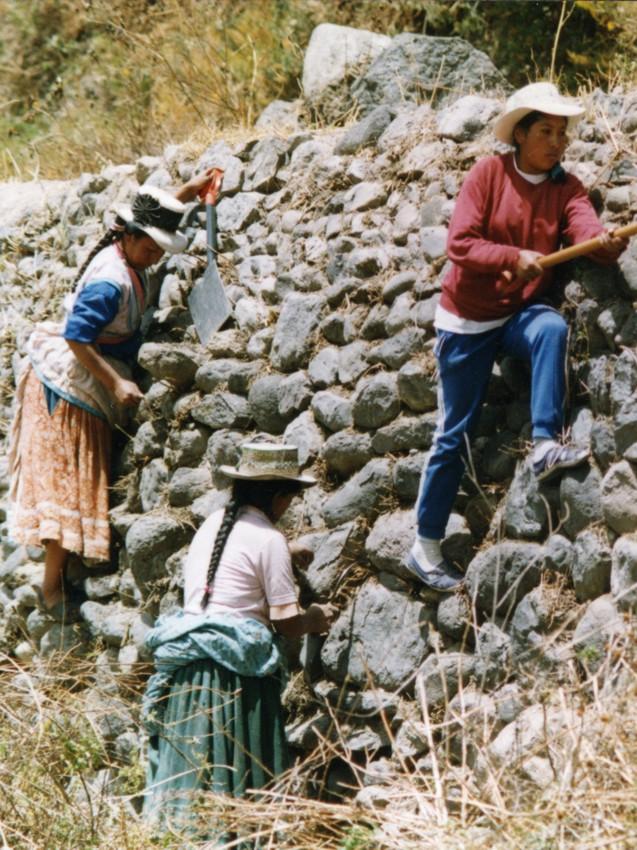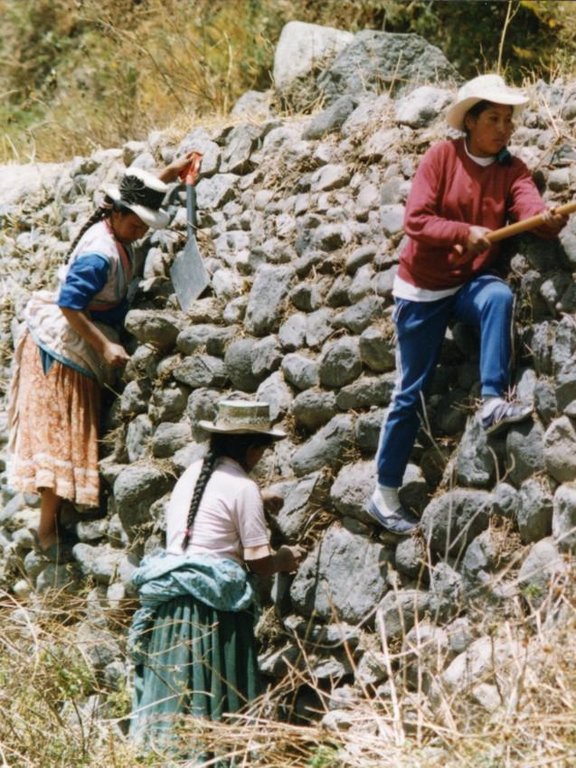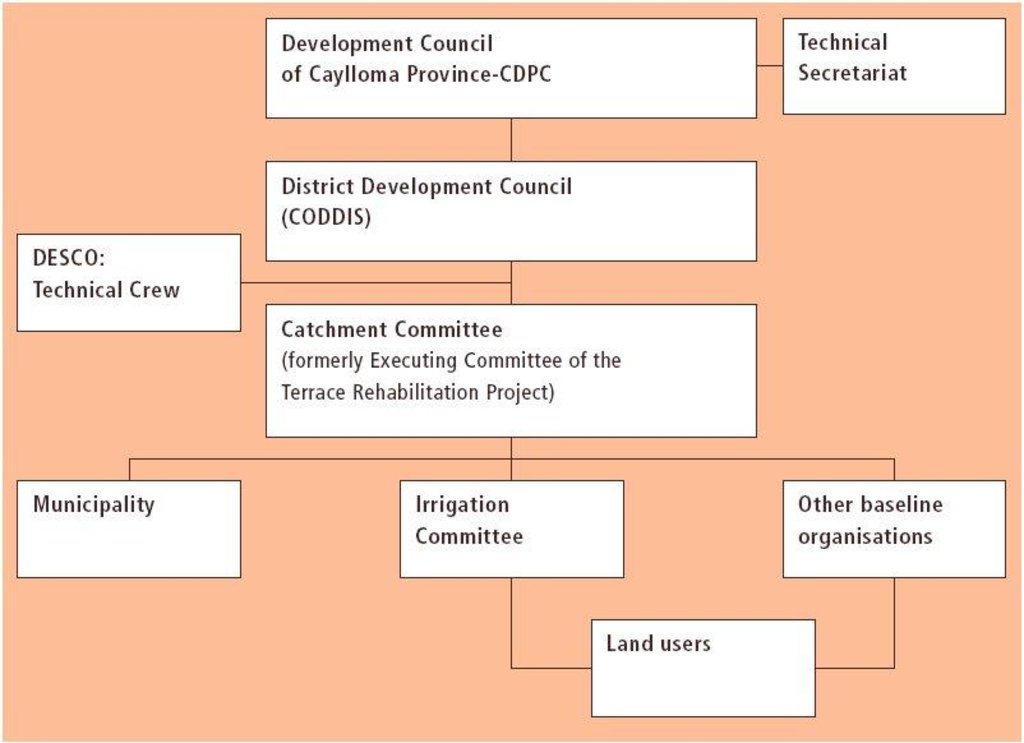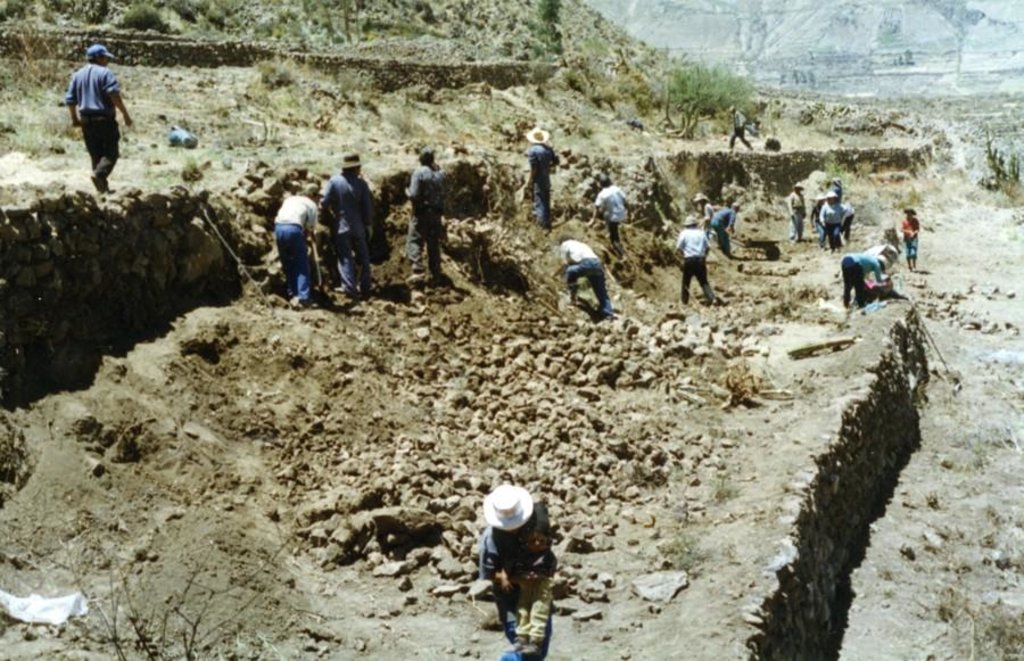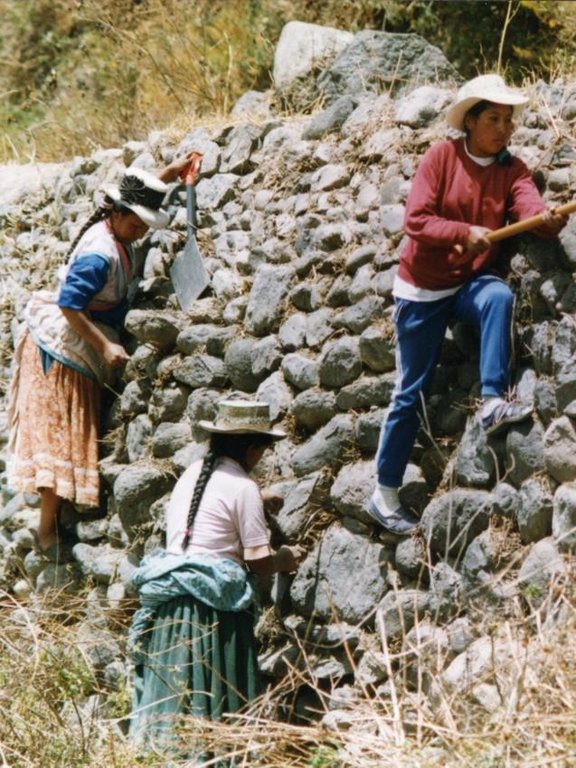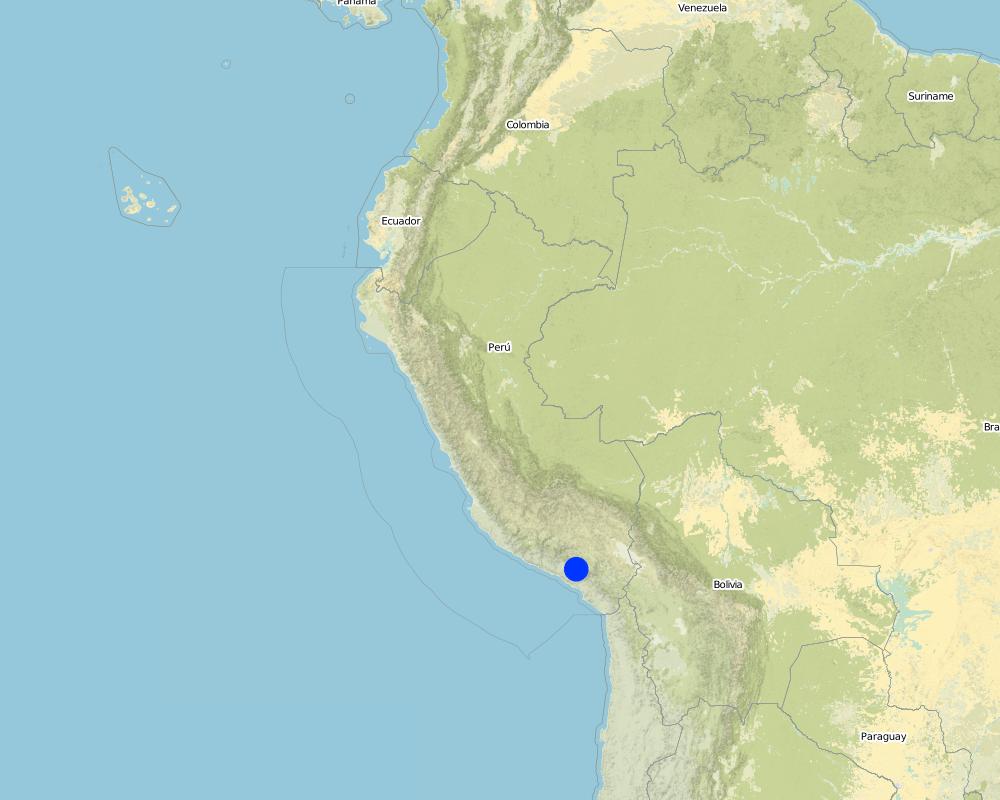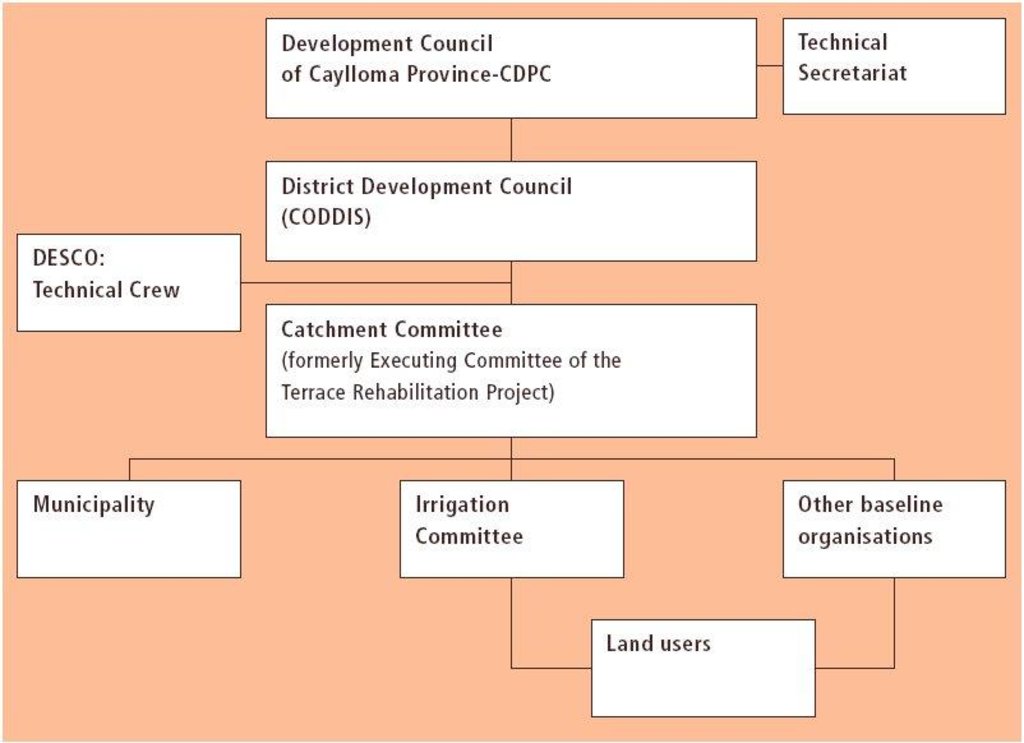Participatory catchment rehabilitation (Participación comunitaria para la rehabilitación de cuencas) [Pérou]
- Création :
- Mise à jour :
- Compilateur : Philippe Zahner
- Rédacteur : –
- Examinateurs : Fabian Ottiger, Deborah Niggli
approaches_2347 - Pérou
Voir les sections
Développer tout Réduire tout1. Informations générales
1.2 Coordonnées des personnes-ressources et des institutions impliquées dans l'évaluation et la documentation de l'Approche
Spécialiste GDT:
Marquina Rodolfo
descolca@terra.com.pe
Centro de Estudios y Promocion del Desarrollo - DESCO
Calle Malaga Grenet No. 678 Umacollo, Arequipa
Pérou
Spécialiste GDT:
Marcacuzco Aquilino P Mejia
Centro de Estudios y Promocion del Desarrollo - DESCO
Calle Malaga Grenet No. 678 Umacollo, Arequipa
Pérou
Nom du projet qui a facilité la documentation/ l'évaluation de l'Approche (si pertinent)
Book project: where the land is greener - Case Studies and Analysis of Soil and Water Conservation Initiatives Worldwide (where the land is greener)Nom du ou des institutions qui ont facilité la documentation/ l'évaluation de l'Approche (si pertinent)
Swiss Agency for Development and Cooperation (DEZA / COSUDE / DDC / SDC) - SuisseNom du ou des institutions qui ont facilité la documentation/ l'évaluation de l'Approche (si pertinent)
Centro de Estudios y Promoción del Desarrollo (DESCO) - Pérou1.3 Conditions relatives à l'utilisation par WOCAT des données documentées
Le compilateur et la(les) personne(s) ressource(s) acceptent les conditions relatives à l'utilisation par WOCAT des données documentées:
Oui
1.4 Références au(x) questionnaire(s) sur les Technologies de GDT
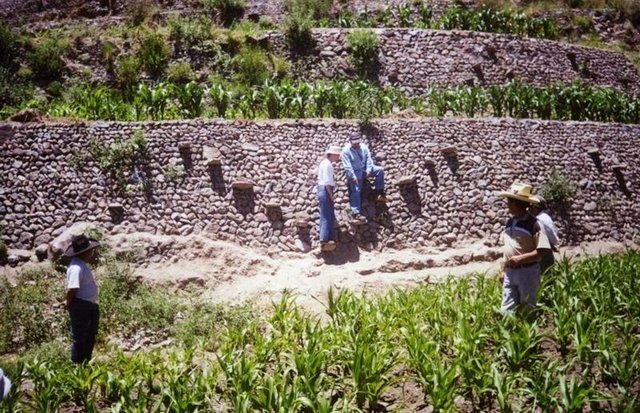
Rehabilitation of ancient terraces [Pérou]
Repair of ancient stone wall bench terraces, and of an associated irrigation and drainage system.
- Compilateur : Unknown User
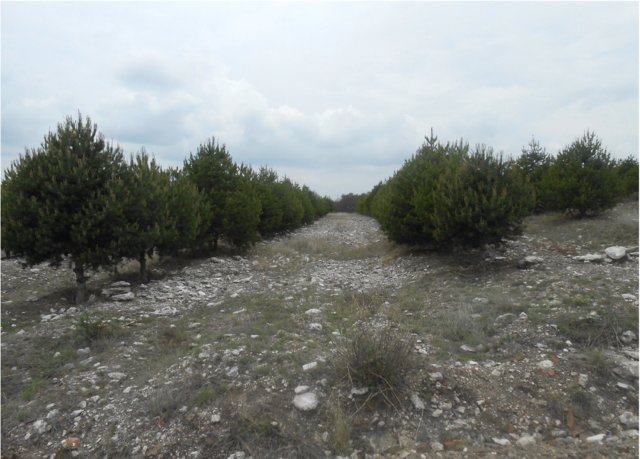
Callejones de piñón con forrajes intercalados [Mexique]
La tecnología consiste en un sistema agrosilvopastoril con árboles de Pinus cembroides (pino piñonero) alineados een bordos ─en un terreno con suelos calizos previamente subsoleado─ conformando melgas (callejones) para con cultivos anuales para grano y forraje, con pastoreo libre eventual por períodos muy breves.
- Compilateur : BENJAMIN SANCHEZ BERNAL
2. Description de l'Approche de GDT
2.1 Courte description de l'Approche
Promoting the rehabilitation of ancient terrace systems based on a systematic watershed management approach.
2.2 Description détaillée de l'Approche
Description détaillée de l'Approche:
Aims / objectives: The Center for Studies and Promotion of Development - DESCO, a Peruvian NGO, started the Terrace Rehabilitation Project in 1993 to re-establish ancient terracing and irrigation practices that had largely been lost. The project is part of a general integrated development programme. Its overall purpose is to restore the productive capacity of terraced cropland, and to generate better living standards in the Colca valley. The project has the following specific objectives: (1) to increase the productive infrastructure through soil conservation and better use and management of existing water resources; (2) to increase levels of production; (3) to stimulate people in soil conservation and land management; and (4) to encourage/promote relevant local institutions. For implementation, a systematic watershed management approach was introduced. The catchment was considered the basic unit for development planning. Physical and socio-economic baseline studies were carried out. A strong community-based organisation, the catchment committee, was then founded. This consisted of representatives of major local grassroots organisations (irrigation committee, farmers' community, mothers' club etc). Responsibilities, commitments and rules were defined. Committee meetings and land user assemblies were the entities for planning, organisation and execution of project activities. DESCO initiated a process of 'concerted planning' in collaboration with other private and public institutions in Caylloma province.
Methods: In summary the project stages comprised: (1) project planning; (2) baseline studies; (3) catchment management plan; (4) constitution of the executive committee; (5) concerted planning of district development; and (6) organisation, execution, technical assistance and follow-up activities. Land users were required to participate in training courses and in fieldwork, to provide local materials and their own tools, and to fulfil duties within the organisations. Leaders and directors of grassroots organisations were responsible for planning and organisation of activities - implementation, training and follow-up - and for control and administration of project materials and inputs. The directors were also elected as representatives in the District Development Councils to participate in the evaluation and monitoring activities of the project.
2.3 Photos de l'approche
2.5 Pays/ région/ lieux où l'Approche a été appliquée
Pays:
Pérou
Région/ Etat/ Province:
Rio Colca
Autres spécifications du lieu :
Arequipa, Peru
Map
×2.6 Dates de début et de fin de l'Approche
Indiquez l'année de démarrage:
1993
2.7 Type d'Approche
- fondé sur un projet/ programme
2.8 Principaux objectifs de l'Approche
- to achieve higher levels of agricultural production and productivity through integrated development/management of soil and water resources. - to build capacity for planning, organisation and implementation of development activities
The SLM Approach addressed the following problems: - lack of employment opportunities/depopulation of rural areas. - lack of planning and action in 'concerted development' - little value associated with terrace rehabilitation. - low and unequal participation of women in field work. - general impoverishment of land users
2.9 Conditions favorisant ou entravant la mise en œuvre de la(des) Technologie(s) appliquée(s) sous l'Approche
normes et valeurs sociales/ culturelles/ religieuses
- entrave
Women were treated unequally in terms of opportunities and salaries
Treatment through the SLM Approach: Equal treatment in salaries and better opportunities were ensured for women.
disponibilité/ accès aux ressources et services financiers
- entrave
The poorest land users lacked the money to invest in terrace rehabilitation.
Treatment through the SLM Approach: Manual labour and tools were subsidised.
cadre institutionnel
- entrave
Coordination of planning and activities was lacking between different institutions and projects.
Treatment through the SLM Approach: District Development Councils (CODDIS) were strengthened as entities for coordination and concerted action.
cadre juridique (régime foncier, droits d'utilisation des terres et de l'eau)
- entrave
There was a lack of legal (registered) institutions to coordinate planning and strategies for sustainable land use at community level.
Treatment through the SLM Approach: An active effort was made to promote legalisation of, and give support to, grassroots organisations (eg Union of Land Users).
connaissances sur la GDT, accès aux supports techniques
- entrave
Local specialists in terrace rehabilitation and for construction supervision were lacking.
Treatment through the SLM Approach: Training and competitions were organised to develop skills and select the best.
autre
- entrave
Economical: Investment in cash crops was a problem for poor smallholders.
Treatment through the SLM Approach: Training/technical assistance was given for more profitable crops e.g potatoes, beans and peas.
3. Participation et rôles des parties prenantes impliquées dans l'Approche
3.1 Parties prenantes impliquées dans l'Approche et rôles
- exploitants locaux des terres / communautés locales
There were no differences in terms of salaries, but there were in terms of job opportunities: in a working group of 20 persons, typically only 5 women were contracted as terrace rehabilitation is very heavy work.
- Spécialistes de la GDT/ conseillers agricoles
- enseignants/ élèves/ étudiants
- gouvernement national (planificateurs, décideurs)
3.2 Participation des exploitants locaux des terres/ communautés locales aux différentes phases de l'Approche
| Participation des exploitants locaux des terres/ communautés locales | Spécifiez qui était impliqué et décrivez les activités | |
|---|---|---|
| initiation/ motivation | interactive | interviews/questionnaires, workshops/seminars, public meetings |
| planification | auto-mobilisation | workshops/seminars; assemblies for decision making, workshops for local concerted planning |
| mise en œuvre | interactive | casual labour, responsibility for minor steps; casual labour, responsibility for minor steps (land users in general); responsibility for major steps (leaders) |
| suivi/ évaluation | interactive | workshop/seminars, reporting, measurements/observations, interviews/questionnaires, public meetings; workshops, measurements/observations (directors of baseline organisations/leaders), reports (directors), interviews (directors/teachers), public meetings (land users) |
| Research | aucun | none |
3.3 Diagramme/ organigramme (si disponible)
Description:
District Development Council (CODDIS): social organisations, public and private institutions jointly prepare economic and social development plans in a participatory manner, and under the leadership o
3.4 Prises de décision pour la sélection de la Technologie/ des Technologies
Indiquez qui a décidé de la sélection de la Technologie/ des Technologies à mettre en œuvre:
- principalement les spécialistes de la GDT, après consultation des exploitants des terres
Expliquez:
the terraces were in an advanced stage of collapse and the local population did not have the means to reverse the process due to lack of economic resources.
Decisions on the method of implementing the SLM Technology were made by mainly by land users supported by SLM specialists. the technology is indigenous and adapted to the area. Evaluation workshops of, and activities permitting discussions on, the technology were carried out.
4. Soutien technique, renforcement des capacités et gestion des connaissances
4.1 Renforcement des capacités/ formation
Une formation a-t-elle été dispensée aux exploitants des terres/ autres parties prenantes?
Oui
Formats de la formation:
- réunions publiques
Formats de la formation:
- exchange of experiences
Thèmes abordés:
A training plan at three levels was drawn up, addressing the following target groups and topics: (1) Selected land users, leaders, supervisors: in-depth training on the interrelations between water, soil and plants; terrace and canal construction; institution/enterprise management; natural resource management, conservation practices, and crop production. (2) Directors of grassroots organisations
4.2 Service de conseils
Les exploitants des terres ont-ils accès à un service de conseils?
Oui
Décrivez/ commentez:
Key elements: technical assistance and sustained follow-up, supervision by specialised engineers, evaluation (reflection) and systematisation of gained know-how and developed practices with different stakeholders, function; testing of rehabilitated structures; Capacity for extension continuation has been built up within the catchment committee. However PRONAMACHS, a governmental SWC programme, is limited
4.3 Renforcement des institutions (développement organisationnel)
Des institutions ont elles été mises en place ou renforcées par le biais de l'Approche?
- oui, beaucoup
Spécifiez à quel(s) niveau(x), ces institutions ont été renforcées ou mises en place:
- local
Précisez le type de soutien:
- financier
- renforcement des capacités/ formation
4.4 Suivi et évaluation
Le suivi et l'évaluation font ils partie de l'Approche? :
Oui
Commentaires:
technical aspects were regular monitored by 0 through measurements; indicators: improved structures, results of technology tests
socio-cultural aspects were ad hoc monitored by 0 through observations; indicators: land users changing attitudes of SWC
economic / production aspects were ad hoc monitored by 0 through measurements; indicators: crop production increase
area treated aspects were regular monitored by 0 through measurements; indicators: rehabilitated area
no. of land users involved aspects were regular monitored by 0 through measurements; indicators: number of households that benefited directly
management of Approach aspects were ad hoc monitored by 0 through observations; indicators: number of catchments rehabilitated with terraces and agroforestry
There were several changes in the Approach as a result of monitoring and evaluation: There were various changes/readjustments of the approach: eg the concerted planning through the Local Development Councils was incorporated 5 years after the initiation of the project.
4.5 Recherche
La recherche a-t-elle fait partie intégrante de l’Approche?
Oui
Spécifiez les thèmes:
- économie/ marketing
- technologie
Donnez plus de détails et indiquez qui a mené ces recherches:
Technology: research has been ongoing regarding functioning of the terrace and irrigation systems. Economy/commercialisation: research regarding agronomic production, catchment appraisals and market studies have been carried out for the main products of the area.
5. Financement et soutien matériel externe
5.1 Budget annuel de la composante GDT de l'Approche
Commentez (par ex. principales sources de financement/ principaux bailleurs de fonds):
Approach costs were met by the following donors: international non-government (International NGO): 60.0%; government (national): 20.0%; local community / land user(s) (-): 20.0%
5.2 Soutiens financiers/ matériels fournis aux exploitants des terres
Les exploitants des terres ont-ils reçu un soutien financier/ matériel pour la mise en œuvre de la Technologie/ des Technologies?
Oui
5.3 Subventions pour des intrants spécifiques (incluant la main d'œuvre)
- équipement
| Spécifiez les intrants subventionnés | Dans quelle mesure | Spécifiez les subventions |
|---|---|---|
| machines | en partie financé | A-frames, tape measures, motor drills, wheelbarrows, shovels, picks, steel bars, sledgehammers,hoes, and compressors |
| outils | en partie financé | |
- intrants agricoles
| Spécifiez les intrants subventionnés | Dans quelle mesure | Spécifiez les subventions |
|---|---|---|
| semences | entièrement financé | Seedlings of tree species for establishment of the agroforestry component on terraces were produced in a project-owned nursery, and they were given free of charge to interested farmers |
Si la main d'œuvre fournie par les exploitants des terres était un intrant substantiel, elle était:
- payée en espèces
Commentaires:
60% of the labour costs were met by the project.
5.4 Crédits
Des crédits ont-ils été alloués à travers l'Approche pour les activités de GDT?
Oui
Spécifiez les conditions (taux d'intérêts, remboursements, etc.):
repayment conditions: Credit was provided by FONDESURCO to land users who participated in the rehabilitation project (for seed supply) with a lower interest rate than on the market. FONDESURCO is an NGO (of which DESCO is a member) specialised in microfinances in the rural sector..
5.5 Autres incitations ou instruments
D'autres incitations ou instruments ont-ils été utilisés pour promouvoir la mise en œuvre des Technologies de GDT?
Oui
Si oui, spécifiez:
Support was provided to existing institutions (in the form of training, organisation and financial inputs). But with the formation of a catchment committee, an important grassroots organisation was built up.
6. Analyses d'impact et conclusions
6.1 Impacts de l'Approche
Est-ce que l'Approche a aidé les exploitants des terres à mettre en œuvre et entretenir les Technologies de GDT?
- Non
- Oui, un peu
- Oui, modérément
- Oui, beaucoup
There have been great improvements: introduction of high-value crops; 100% of the area cultivable; reduction of irrigation frequency by 20% due to higher efficiency of water storage by the terraces; various other SWC benefits.
Did other land users / projects adopt the Approach?
- Non
- Oui, un peu
- Oui, modérément
- Oui, beaucoup
A few other projects have adopted the approach: eg the project of the Banco de Vivienda PRATVIR in the Coporaque area; also 'Popular Cooperation' in Ichupampa (covering just 2 ha).
6.3 Durabilité des activités de l'Approche
Les exploitants des terres peuvent-ils poursuivre ce qui a été mis en œuvre par le biais de l'Approche (sans soutien extérieur)?
- oui
Si oui, décrivez de quelle manière:
Land users can continue the activities without external support, using traditional systems of mutual help and new forms of local organisation (catchment committee). With increased income through integration of cash crops the maintenance of the structures can be sustained.
6.4 Points forts/ avantages de l'Approche
| Points forts/ avantages/ possibilités du point de vue du compilateur ou d'une autre personne ressource clé |
|---|
| Complementary conservation practices have been integrated into the terraces system: agroforestry, improved fallow, etc (How to sustain/ enhance this strength: Training of land users in the advantages and disadvantages of these practices.) |
| nstitutional capacity building: strengthening of organisations; increased participation (How to sustain/ enhance this strength: Continue the training of leaders.) |
| SWC training and extension activities. (How to sustain/ enhance this strength: Create spaces and mechanisms for daily practice of important cultural rituals/customs.) |
| 80% of land users have changed attitudes towards SWC, and are convinced of the benefits of terrace rehabilitation (How to sustain/ enhance this strength: SWC training and extension activities.) |
| Human capacity building: 60 specialists trained in rehabilitation technology (How to sustain/ enhance this strength: Create opportunities to ensure continuation of their work.) |
| An effective systematic watershed management approach applied at catchment level (How to sustain/ enhance this strength: Other projects/institutions should apply this approach.) |
| Soil conservation activities integrated in the plans of 'concerted development' (How to sustain/ enhance this strength: Strengthening of the Local Development Councils (CODDIS).) |
6.5 Faiblesses/ inconvénients de l'Approche et moyens de les surmonter
| Faiblesses/ inconvénients/ risques du point de vue du compilateur ou d'une autre personne ressource clé | Comment peuvent-ils être surmontés? |
|---|---|
| Labour overload in the family | Better planning of work at the household level. |
| The approach requires the participation of all social and political stakeholders - which is practically impossible | Strengthen the Local Development Councils (CODDIS). |
| The generation of income encourages the purchase of industrialised products | More training regarding consumption of local products. |
| The economic incentives provided by the project affected the existing reciprocal relationships (eg labour exchange) | Cash for work incentives are sometimes useful to overcome labour constraints due to depopulation. |
| Small holdings and land fragmentation are constraints for cost-effective agriculture | Accelerate the process of land consolidation and entitlement. |
| Changes in leadership interrupt planned processes (of activities) | Permanent training to encourage leadership qualities. |
| Lack of a crop and irrigation plan for better water management | Elaboration and application of a plan. |
7. Références et liens
7.1 Méthodes/ sources d'information
- visites de terrain, enquêtes sur le terrain
- interviews/entretiens avec les exploitants des terres
Liens et modules
Développer tout Réduire toutLiens

Rehabilitation of ancient terraces [Pérou]
Repair of ancient stone wall bench terraces, and of an associated irrigation and drainage system.
- Compilateur : Unknown User

Callejones de piñón con forrajes intercalados [Mexique]
La tecnología consiste en un sistema agrosilvopastoril con árboles de Pinus cembroides (pino piñonero) alineados een bordos ─en un terreno con suelos calizos previamente subsoleado─ conformando melgas (callejones) para con cultivos anuales para grano y forraje, con pastoreo libre eventual por períodos muy breves.
- Compilateur : BENJAMIN SANCHEZ BERNAL
Modules
Aucun module trouvé


